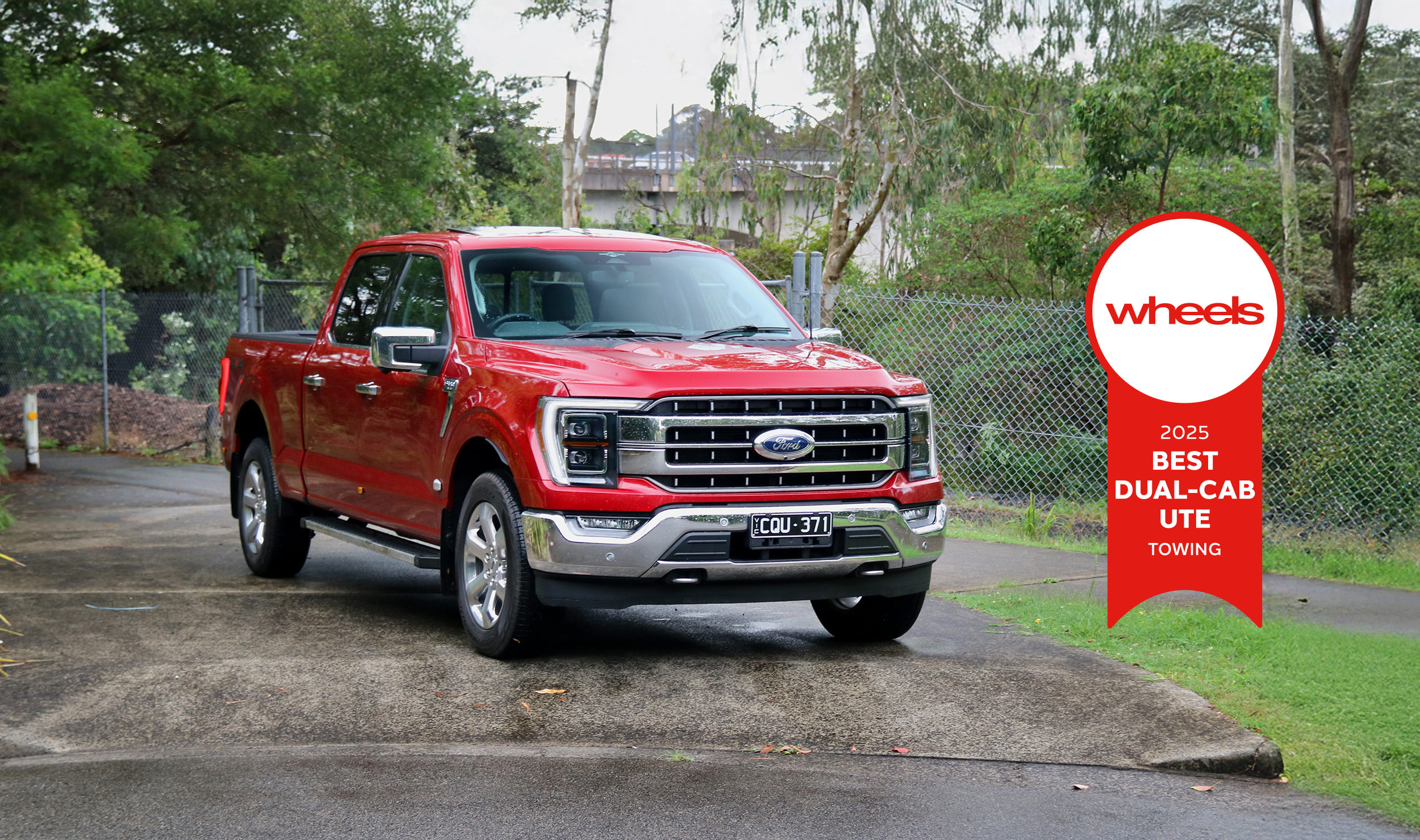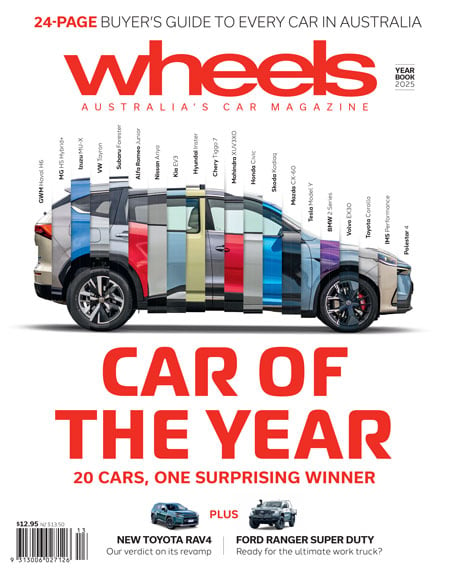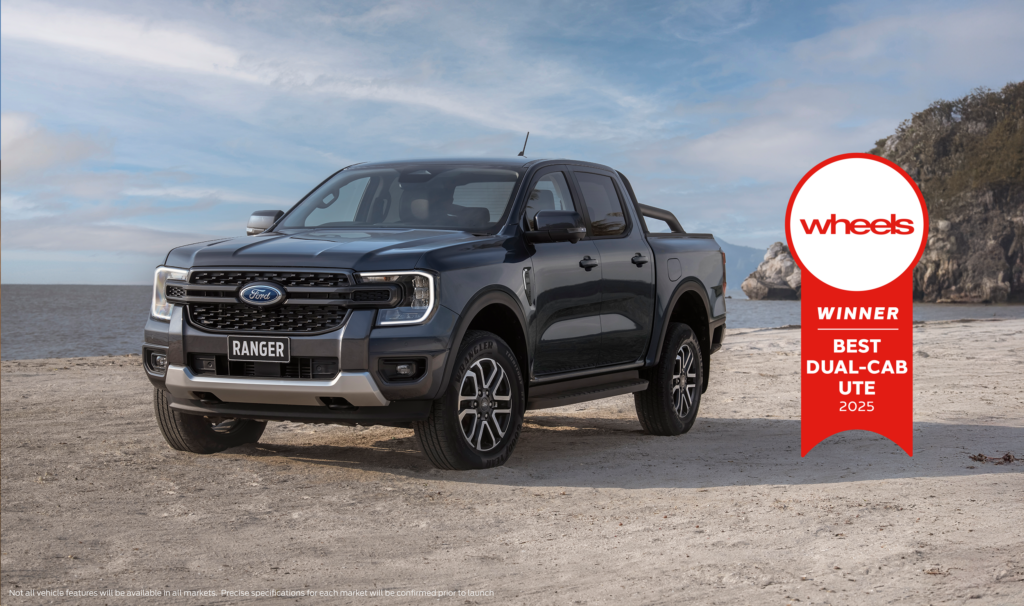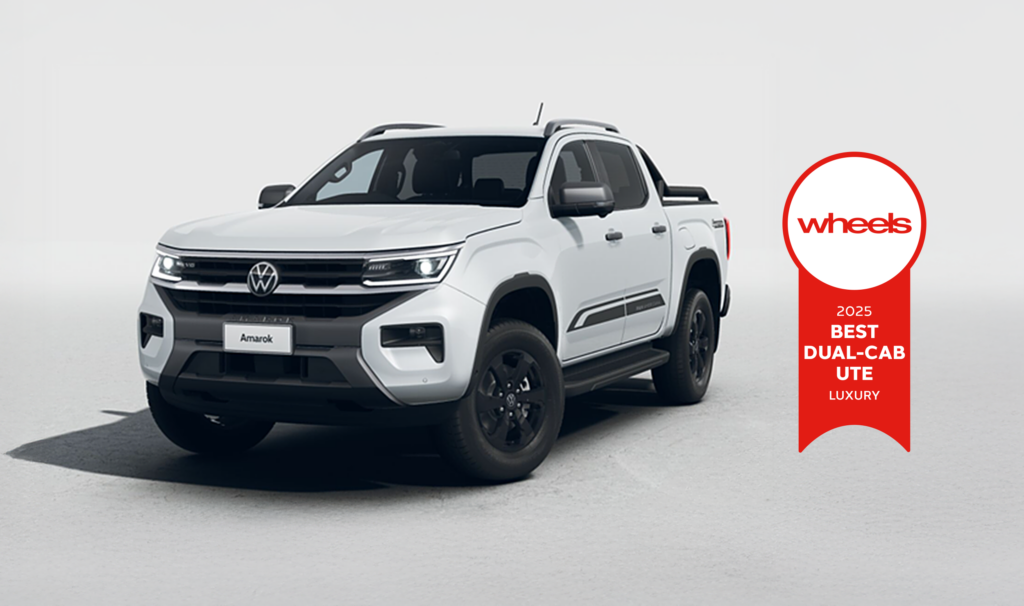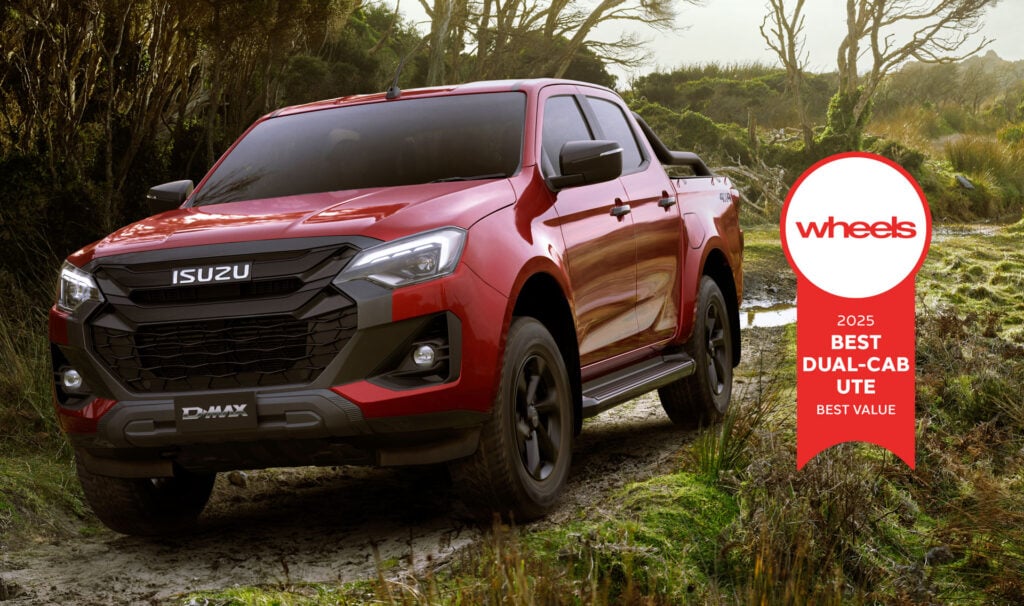Contenders
Winner: Ford F-150
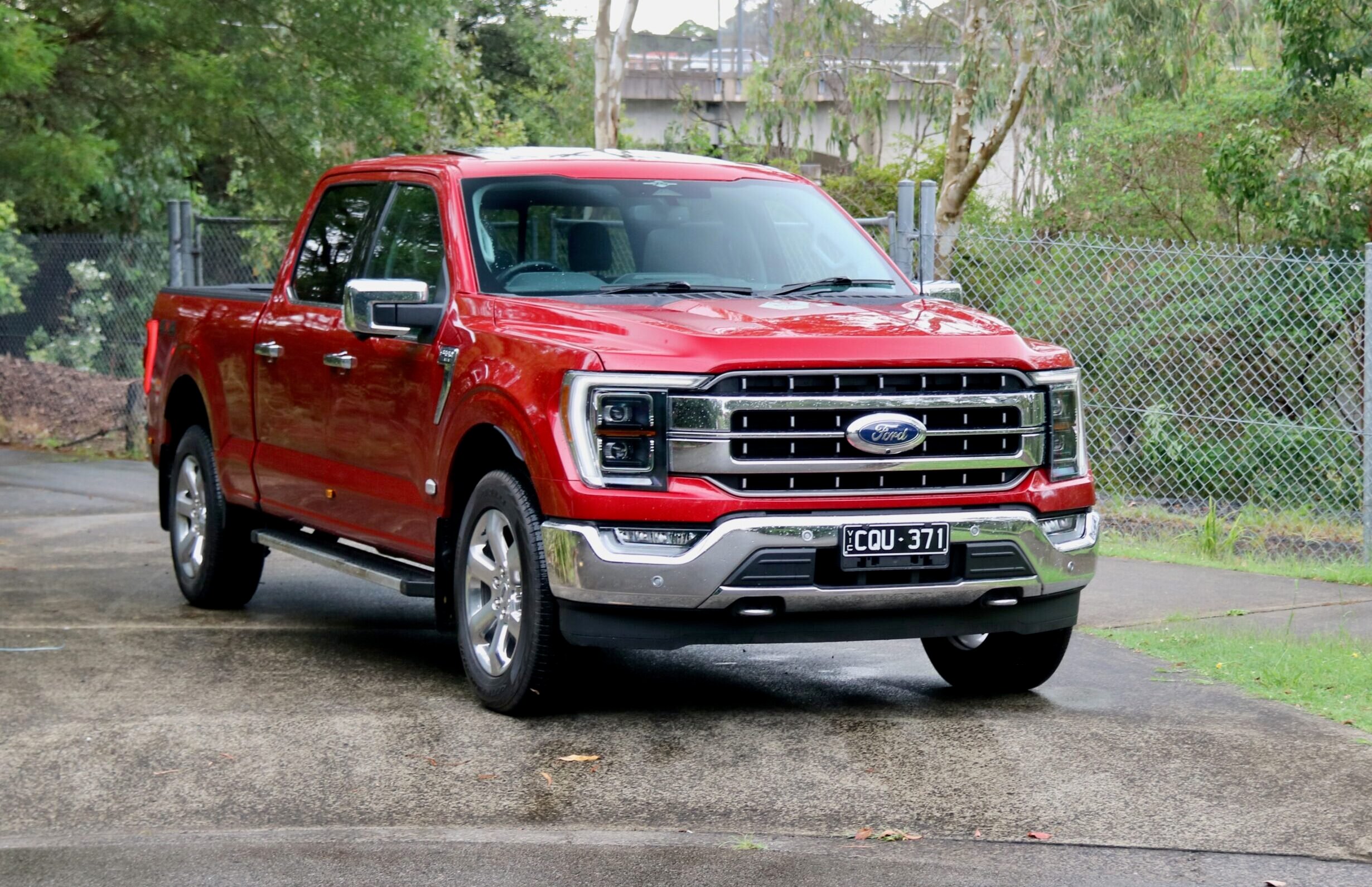
- Price: From $106,950 plus on-road costs
- Drivetrain: 3.5L V6 petrol engine, 298kW/678Nm, 10-speed auto
- Combined fuel economy, CO2 emissions, fuel type: 12.5L/100km, 290g/km, 95RON
- Warranty: Five year, unlimited kilometre
- Five-year service cost: $2145 ($429 per year)
| Driving | |
|---|---|
| Interior | |
| Practicality | |
| Overall value |
Things we like
- Rides well for a big ‘un
- Slick towing technology
- Huge 136-litre fuel tank gives it legs
Not so much
- Feels like a leviathan
- Huge trim/price step from XLT to Lariat
- Need to step up to Lariat to avoid feeble halogen headlights
Nobody wants to tow anything. It’s a one of those activities that occasionally needs doing and is always more pleasurable when the vehicle you’re towing with takes as much strain as possible out of the process. That’s why the Ford F-150 reigns supreme in this category. Towing is what it’s for and its designers have clearly thought long and hard about how to get the very best from it in that regard. It doesn’t pretend at any off-road capability and it isn’t trying to be sporty. Want to drag a big boat, a horse float or heavy equipment? Here’s your rig.
Now it won’t have escaped your attention that the 4500kg towing class is stacked with a few capable contenders. Where the big Effie differentiates itself is firstly in the sophistication of its towing technology and secondly with a fuel tank that’s just, well, bigger. At 136 litres, it dwarfs the capacities of its key rivals and takes the range anxiety out of heavy towing. Couple that with the added benefit that the 3.5-litre V6 engine is, if anything, a little more economical than its published figures and it means that if you’ve got a caravan on the back, you won’t be eyeing the fuel gauge nervously every five minutes.
The other major benefit is that you won’t need to pack super-light. Even when taking a 10 pe rcent tow ball mass into consideration, the short wheelbase F-150 aces the likes of the Tundra, RAM and Silverado. It is, along with the Tundra, one of the only utes that can legitimately tow a 4500kg trailer without running into a Gross Combination Mass issue. And where you have 502kg of payload available to you in the Ford when you have a 4500kg trailer on the back, in the Tundra you’re left with 278kg. So if size really does matter, the F-150 wins.
F-150 buyers also get Pro-Trailer backup assist, which means you can steer the trailer in reverse by using a jog wheel. Some find this more intuitive, but experienced users will continue to twirl the steering wheel. The inbuilt trailer light check function is handy, running through a series off lighting checks that you can do yourself without having to call upon an assistant. Enter the length of your trailer into the infotainment system and the blind-spot monitoring will also take into account the combined length of vehicle and trailer and warn you accordingly when you’re thinking of switching lanes. The reversing camera also provides a top-down view of your tow ball so that you can position it perfectly when hitching up.
This combination of qualities, paired with probably the best ride quality in class, elevate the F-150 above the rest when it comes to towing. Couple that with strong value for money and line honours here are claimed, fairly comprehensively, by the Blue Oval.
Toyota Tundra
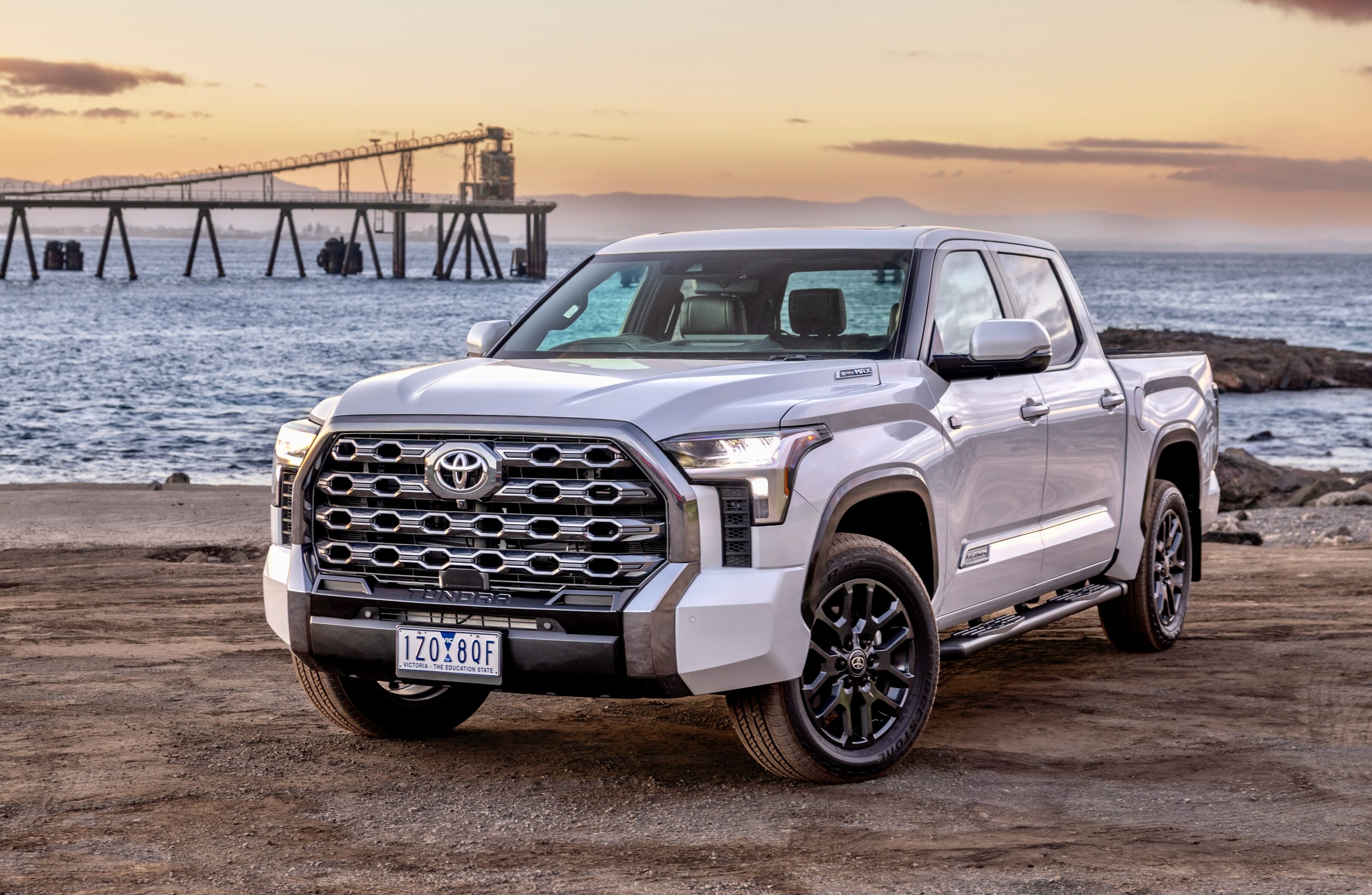
- Price: $155,990 plus on-road costs
- Drivetrain: 3.4L V6 hybrid petrol engine, 326kW/790Nm, 10-speed auto
- Combined fuel economy, CO2 emissions, fuel type: 11.8L/100km, 290g/km, 95RON
- Warranty: Five year, unlimited kilometre
- Five-year service cost: $4500 ($900 per year)
| Driving | |
|---|---|
| Interior | |
| Practicality | |
| Overall value |
Things we like
- Hybrid drive gives instant go off the line
- Decent towing technology
- Toyota’s RHD conversion work has been painstaking
Not so much
- It’s expensive
- Complexity of hybrid might be off-putting to some
- Ride is firmish
We awaited a long time for the Toyota Tundra. If you weren’t quick on the draw with placing your order you might still be waiting. There’s a very good reason for that. Toyota Australia was keen to dot every ‘i’ and cross every ‘t’ when it came to the engineering rectitude of its work in partnership with Walkinshaw. Get the Tundra right and the door could well open for other projects. Get this lengthy validation process wrong (it kicked off in 2017) and there’s a supersized serving of egg on face down in Altona.
Billed as Toyota’s ‘premium towing machine’, the Tundra focused on space, comfort and a long driving range. It features coil springs at the rear rather than the expected leaf springs, Toyota prioritising lateral location when towing over sheer carrying capacity in the tray.
The 3445cc i-FORCE MAX petrol V6 engine isn’t the run-of-the-mill lump of iron either. Featuring a motor-generator that adds 36kW and 140Nm, the system output is – now that the RAM TRX is dead – a monster 326kW and 780Nm. Best of all, the control systems ensure that that torque fill is instantly available off the line, which is the time that you feel most in need of it when towing a big trailer.
The ride quality is a little flinty on poor Aussie roads, which is surprising, and this can filter into the cabin setting up squeaks and rattles among the many hard plastic trim parts. Maybe that perception is exacerbated by the fact that the hybrid petrol drivetrain is incredibly refined. Buyers get an integrated brake controller, a couple of towing-specific drive programs, trailer sway assist and a clever trailer back-up assistant.
The Tundra also features a decent 122-litre fuel tank which, coupled with the best fuel economy in this class, gives it decent touring range. Unlike an F-150, there’s no low-range transfer case, so if you’re trying to drag a caravan up a wet and bumpy paddock, you’re reliant on 4H mode and some very road-biased Bridgestone Dueler rubber.
Toyota has capacity to convert 1200 Tundras per year, and is more than confident about shifting every one of them without having to mark down that $155,990 asking price. They’re probably right, as there’s a ready market here for not just a vehicle with this blend of qualities, but a Toyota vehicle with this blend of qualities. The badge carries serious clout in both town and country Australia. For many, it’ll be their first and last port of call in the 4.5-tonne class.
Chevrolet Silverado 1500
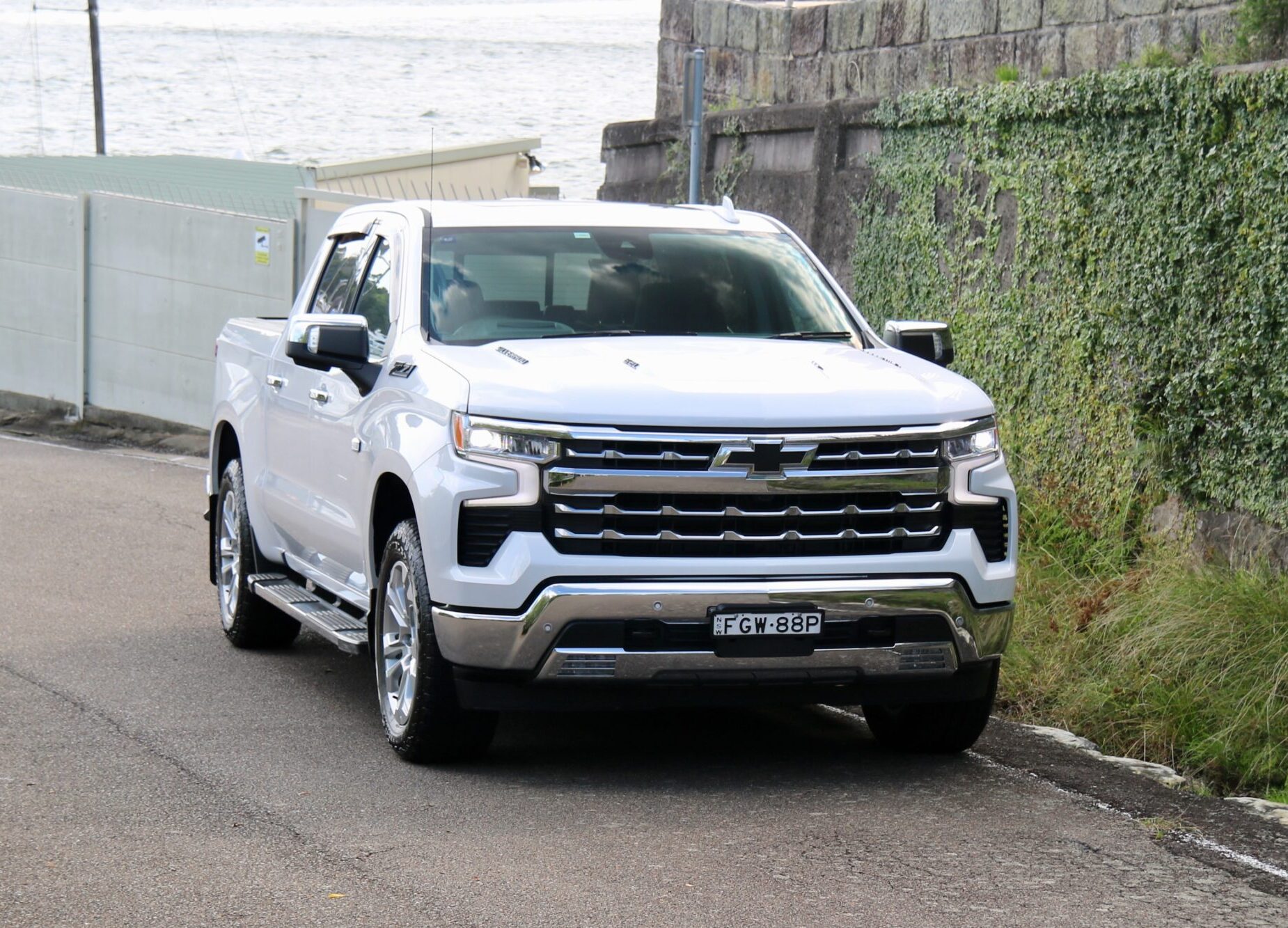
- Price: From $130,500 plus on-road costs
- Drivetrain: 6.2L V8 petrol engine, 313kW/624Nm, 10-speed auto
- Combined fuel economy, CO2 emissions, fuel type: 16.8L/100km, 290g/km, 95RON
- Warranty: three year, 100,000 kilometre
- Five-year service cost: Conditional
| Driving | |
|---|---|
| Interior | |
| Practicality | |
| Overall value |
Things we like
- It’s still got a big, characterful V8
- Respectable towing technology
- ZR2 has decent off-road ability
Not so much
- No capped price servicing deal
- Can it tow 4500kg in the real world?
- Unexceptional three-year warranty
There’s nothing apologetic about a Chevrolet Silverado. It’s big, in your face and under the bonnet there’s a 6.2-litre V8 that isn’t shy of reminding people of its presence. If that all sounds a bit too much, there are plenty of competing attractions. If ‘less is more’ sounds like the playbook for a dull life, you’re probably going to love the big Chev.
Like many of its key rivals in this class, the Silverado doesn’t start life as a right-hand drive vehicle. It is comprehensively re-engineered by Walkinshaw in Clayton, who have been doing this for quite a while now and know their stuff. Such is the quality of their work that you’d never know that the steering wheel was once on the other side.
As a tow vehicle, there’s a lot in the plus column. Two models are available, the LTZ Premium, priced at $130,500 and the more off-road focused ZR2 at $138,500. Both are powered by the same 6.2-litre naturally aspirated petrol V8. While the 624Nm torque figure sounds meaty enough, without the benefit of either forced induction or hybrid assistance, that peak is achieved at a relatively lively 4100rpm, and at 2000rpm, that drops off to around 470Nm.
Nevertheless on back-to-back heavy towing economy tests with the Ford 3.5-litre Ecoboost, it returns marginally better fuel figures. You will find the engine downshifting more to make its power when compared with the turbocharged Ford F-150, but the 10-speed transmission is quick-witted and while the V8 can get somewhat vocal when pressed, such as on long inclines, there’s a constituency of buyers who would rate the long term reliability of a big atmo powerplant over that of a downsized turbocharged unit.
With a Gross Combination Mass (GCM) of 7160kg for the lTZ and 6851kg for the ZR2, both run into some mathematical issues when towing heavy loads. Drag a 4500kg caravan and when you deduct the LTZ’s kerb weight, you have a mere 117kg of payload before you’ve maxed out your GCM. That’s little more than me and the clothes I stand up in. So, in most practical instances you’ll need to lower your gaze a little with towing weights.
Fortunately, it earns a stack of credit with a whole host of features designed to make towing a whole lot easier. There’s Trailer Sway Control, Hill Start Assist and Auto Grade Braking. You’ll also get Trailer Theft Alert, Electric Parking Brake Hookup Assist and Brake Gain Memory on the integrated trailer brake controller. The Silverado’s Advanced Trailer System includes a pre-departure checklist, light sequencing, maintenance reminders and security alerts. The system can also provide trailer electrical diagnostics and monitor tyre pressure. Every Silverado is also fitted as standard with the Trailering Package, comprising a fitted tow bar, towing hitch platform and 12-pin connector. Then it’s down to you to choose your tow ball: 50mm diameter for towing up to 3.5 tonnes or 70mm for heavier assignments.
The ZR2 model, with its Multimatic DSSV dampers and Goodyear Wrangler Mud Terrain tyres is the best 4.5-tonne ute pick if you’re heading off road, but look out for a slightly reduced tow capacity and squirmier tread blocks when towing on road. If you’re not about to drag a huge load out bush, stick with the cheaper LTZ.
RAM 1500
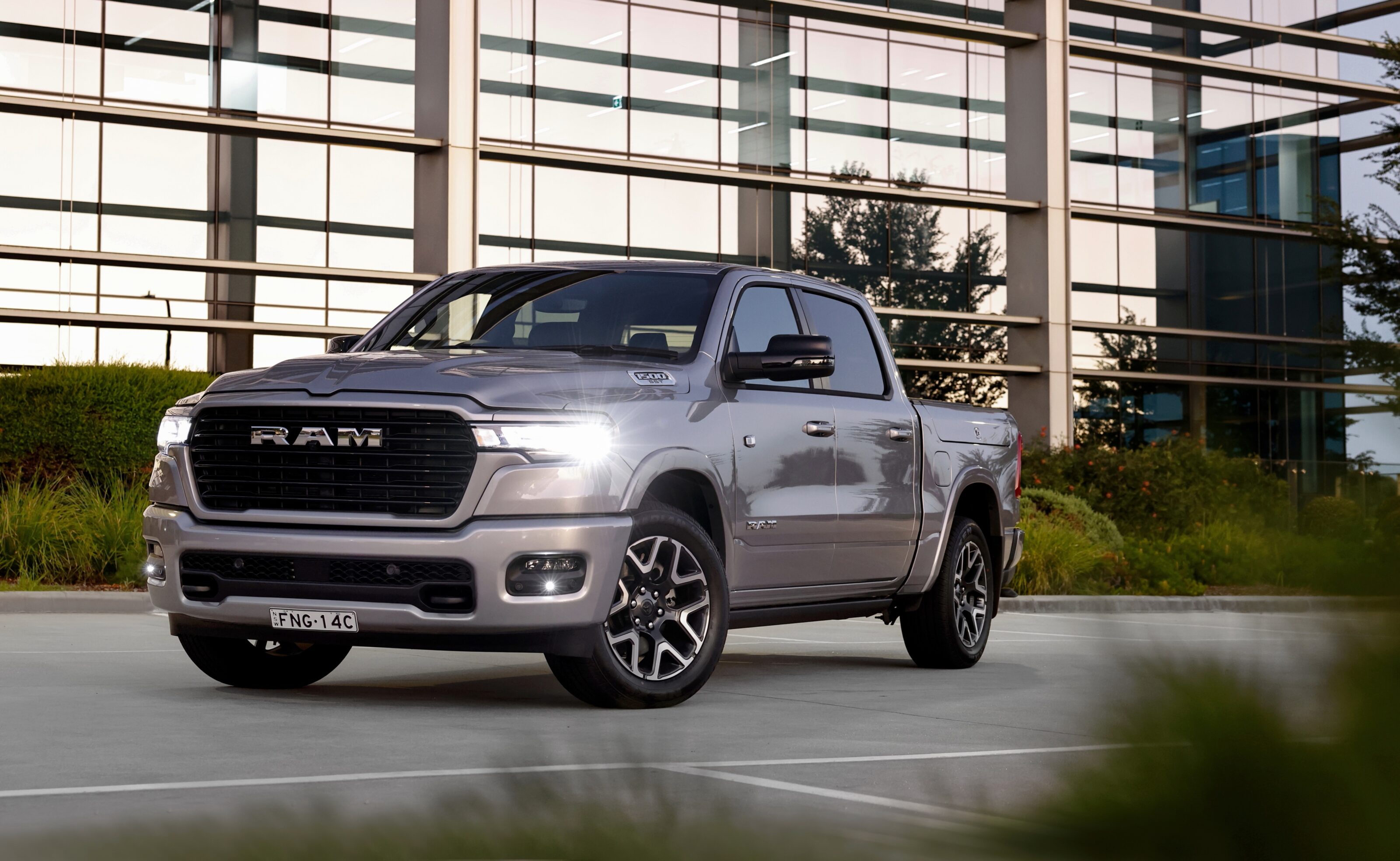
- Price: From $141,950 plus on-road costs (Laramie Sport) – $159,950 +ORC (Limited)
- Drivetrain/economy/CO2 emissions: 3.0L turbo-petrol inline six: 313kW/635Nm (Standard Output) – 403kW/707Nm (High Output), eight-speed auto, 4WD, 10.7-11.8L/100km, TBC CO2
- Dimensions: 5916mm long, 2057mm wide, 1971mm tall, 3672mm long wheelbase
- Towing capacity/GVM/GCM: 4200kg (High Output) – 4500kg (Standard Output)/3505kg (High Output) – 3521kg (Standard Output)/7285kg (High Output) – 7711kg (Standard Output)
- Warranty/roadside assistance/service intervals: Three-year/100,000km warranty, three years of roadside assistance, annual/12,000km
- Five-year service cost: No capped price servicing
| Driving | |
|---|---|
| Interior | |
| Practicality | |
| Overall value |
Things we like
- Monster power and torque from inline-6
- Still looks the business
- Feature-packed cabin
Not so much
- Avoid 22-inch wheels if you value ride quality
- Powerhouse Limited model towing capped at 4200kg
- Three-year warranty and no capped price servicing
This DT generation is the fifth iteration of the big Ram ute and debuted back in 2019. Most associate a Ram ute with one engine: the 6.4-litre Hemi V8. And it is a heck of a powerplant. Times, they are a-changing though and the new generation of RAM 1500 models no longer get the bent-eight. Instead, Australia gets a 3.0-litre twin-turbocharged inline-6 in two discrete guises: either a 313kW/635Nm output in the entry-level Laramie Sport or – counterintuitively – a 403kW/717Nm tune in the Limited. And yes, in case you were wondering, even the lower output of those engines is punchier than the old standard trim Hemi.
The new engine has been a point of controversy for buyers, mostly because the Hemi V8 that the Ram used to use is a legendary engine. The company has promised to revive it in the US for 2026, under the marketing strapline ‘Symbol Of Protest’, but it’s yet to be locked in for Australia. Even if it does arrive here, it’ll be a little shy of the Hurricane twin-turbo inline-six’s massive 403kW of power and 707Nm of torque in the higher-output version.
Whereas those looking to tow a massive trailer might instantly gravitate to the one with the big torque figure, things aren’t quite so cut and dried in real life. With its 22-inch wheels, Pirelli Scorpion tyres, air springs, firmer ride and heavier kerb weight, the high output Limited is, in effect, the less competent tow vehicle, with a maximum braked figure of 4200kg versus the steel-sprung Sport’s 4500kg rating.
Some might baulk at the new entry price into Ram 1500 ownership. The $141,950 RRP of the Sport looks like a hefty $22k hike, but almost all of that premium is due to the fact that there’s no longer – for the time being at least – a budget Big Horn variant on offer. From there it’s a big step up to the $159,950 Limited.
Nevertheless, even the base Sport gets a stack of gear including heated and ventilated leather seats for everyone, LED headlights, dual wireless phone charging, a 14.2-inch centre touchscreen, and a decent Harmon Kardon sound system. There’s even a 10.5-inch passenger screen. What you will miss however, are the sort of towing technologies and smart camera systems that put the Ford F-150 at the head of this particular test.
As well as standard four-wheel drive with low ratio transfer case, the Ram 1500 gets a slick 4WD auto mode that allows it to be driven on the blacktop with 4WD engaged. That’s handy in the wet. Five drive modes are offered including a towing-specific map. Unfortunately, the fuel tank only holds 98 litres, which is some 28 per cent smaller than the standard item on the Ford F-150.
All up, this round of changes has given the Ram 1500 a new lease of life. It remains a competent tow vehicle, but unlike those big utes that are built for towing and little else, perhaps the Ram has a few other strings to its bow.
Ford Ranger V6

- Price: From $68,840 plus on-road costs
- Drivetrain: 3.0L V6 turbodiesel engine, 184kW/600Nm, 10-speed auto
- Combined fuel economy, CO2 emissions, fuel type: 8.4L/100km, 222g/km, 95RON
- Warranty: Five years, unlimited kilometre
- Five-year service cost: $1895 ($379 per year)
| Driving | |
|---|---|
| Interior | |
| Practicality | |
| Overall value |
Things we like
- V6 engine has the herbs for towing
- Clever towing tech
- Great ride and refinement
Not so much
- Some nagging reliability grumbles that Ford has addressed
- Prices keep creeping up
- Do you want to wait for the facelifted version?
Let’s assume for a moment you’re not trying to drag an errant tectonic plate back into position and require a mere 3.5-tonne braked towing capacity. You don’t need a ute that requires council planning permission for your garage extension. Instead, how about something a bit easier to wrangle? Something like the Ford Ranger V6.
It’s no great secret why the Ranger has regularly topped the charts as Australia’s best-selling vehicle. It drives well, it’s packed with no-nonsense good ideas and, as a tow vehicle, it takes a lot of beating. The 3.0-litre diesel V6 versions feature a meaty 184kW/600Nm output and while that engine can trace its roots back almost as far as the demise of the dinosaurs, it still aces pretty much everything else in a comparable price bracket.
Pick, say, the Ranger Sport V6 and you have a GCM of 6400kg and when towing a 3500kg trailer, you have a payload of 555kg. Just a word to the wise: don’t be tempted to spring for a Raptor on the basis that it has more power. Torque is down on the diesel V6 and its peak rated towing capacity is a mere 2500kg.
In other words, when you’re at maximum towing capacity, the Ranger V6 has more payload available to you than any of the big 4500kg-rated trucks. It’s a genuinely strong towing package too, with a dedicated Tow/Haul drive mode which will hold gears longer to prevent the engine labouring. There’s also a ‘manual’ shifting mode on the 10-speed auto which allows you to knock the vehicle down a gear or two if you’d rather engage a bit more engine braking on a downhill incline. That’s reassuring, as is the 4A setting that allows you to run 4WD on road to alleviate the problem of rear traction in the wet.
Standard tech helps you manoeuvre the Ranger cleanly towards your trailer, with a centre line marked on the camera image that almost always guarantees a bullseye on the tow hitch. The optional Touring Pack includes a 360-degree camera and an integrated brake controller. The SYNC4 infotainment allows for easy configuration of your trailer and it will amend rear cross traffic alert and blind spot monitoring accordingly. The trailer light check mode is simple genius.
There’s a reason why the Ford Ranger is currently Australia’s most popular tow car. It’s clever, it drives well, there’s stacks of aftermarket support for it and it takes the stress out of towing. You can’t ask for much more than that. Or if you think you can, wait for the forthcoming Ranger Super Duty.
Volkswagen Amarok V6
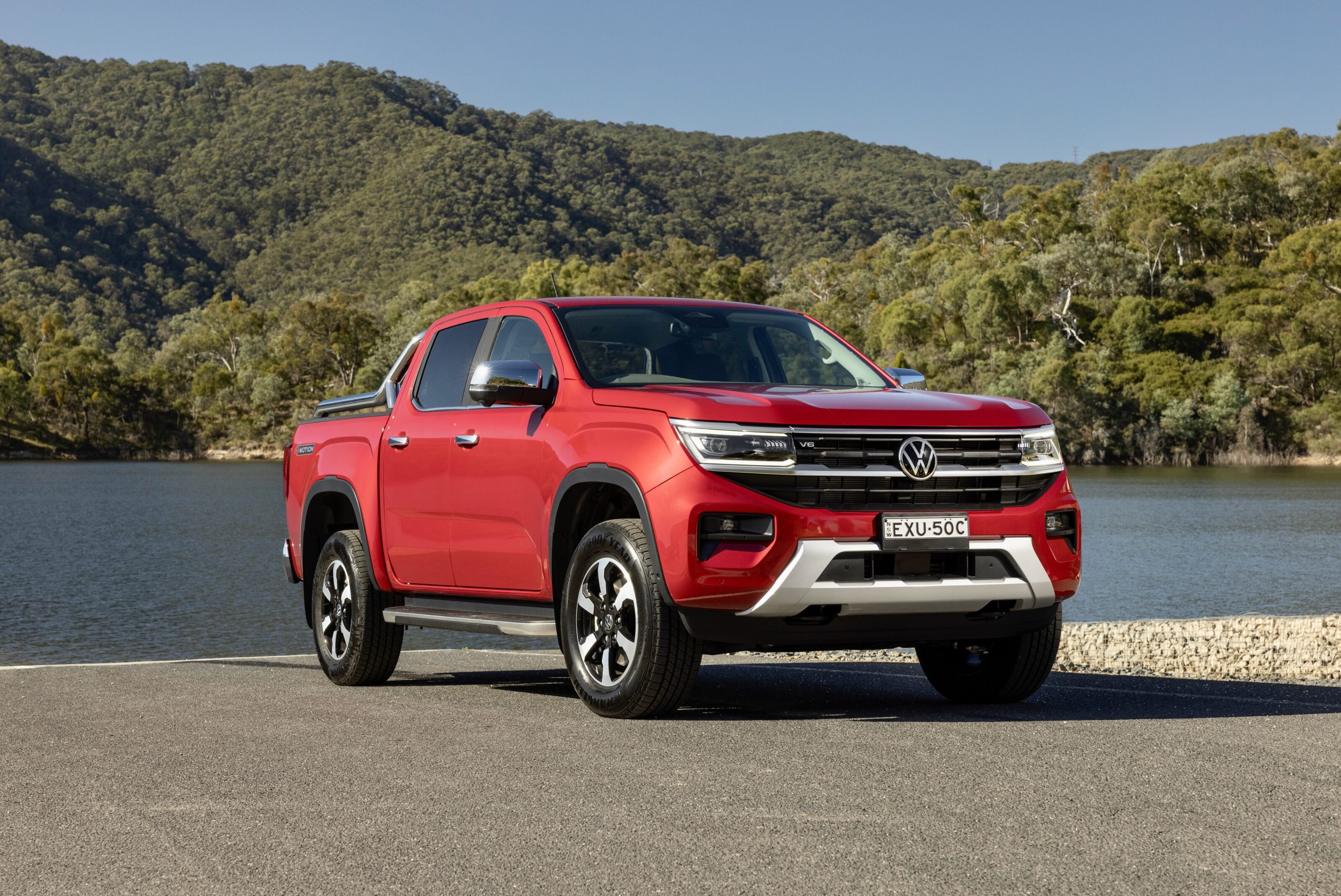
- Price: From $70,990 plus on-road costs
- Drivetrain: 3.0L V6 turbodiesel engine, 184kW/600Nm, 10-speed auto
- Combined fuel economy, CO2 emissions, fuel type: 8.4L/100km, 222g/km, 95RON
- Warranty: Five years, unlimited kilometre
- Five-year service cost: $1800 ($360 per year)
| Driving | |
| Interior | |
| Practicality | |
| Overall value |
Things we like
- Grunty V6 powerplant
- Slick Volkswagen styling
- Excellent ride and refinement
Not so much
- Some don’t rate the 10-speed auto’s reliability record
- A smidge pricier than the Ford Ranger
- Touchscreen control for off-road functions not always ideal
Volkswagen tends to try to excommunicate any of us that link its excellent Amarok ute in any way with the Ford Ranger, despite them sharing underpinnings, but we value the truth over being on Vee-Dub’s Christmas card list, so many of the attributes you’ll have read about for the Ford Ranger V6 previously apply equally to the Volkswagen Amarok.
It shares a lot of the really clever software for towing with the Ford, but the infotainment system has had a slick and effective res-skin in Volkswagen corporate fonts and layouts, which integrates well with the rest of the Amarok’s interior, which uses some high quality materials and finishes to elevate it above the smart but functional Ranger cabin.
Equipment levels are extremely strong, and even the entry-level Style model features gear like adaptive matrix LED headlights, 18-inch alloy wheels, a stainless steel sports bar and keyless go. Its microfibre upholstery is hardwearing and won’t freeze or roast you in the extremes of Australian conditions. You’ll find inclusions on the Style that you won’t find on the (broadly equivalent) Ranger Wildtrak including a 10-way power adjustable driver’s seat and leather-look inserts on the dash to add a bit of luxe.
A tow bar is fitted as standard and Volkswagen has released a whole range of approved accessories for the Amarok which include a lift kit, underbody protection. Like the Ranger, it offers all of the off-road ability including a low-range transmission, so it’s a great choice if your idea of towing is with an adventure caravan heading out into the more remote parts of the Aussie map. If you don’t want to follow the Ranger crowd, the Volkswagen Amarok V6 is a very convincing proposition.

